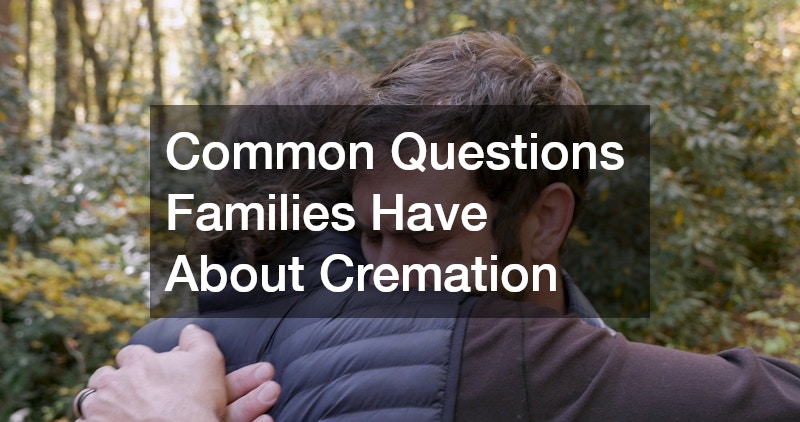When it comes to planning for the end of life, many families find themselves contemplating the choice between burial and cremation. This decision can be influenced by various factors including personal preferences, cultural beliefs, and financial considerations. To assist families in making an informed decision, this article addresses some of the most common questions people have about funeral home cremation services.
What is the Cremation Process?
The cremation process is a respectful method of body disposal that involves reducing the body to bone fragments through intense heat. Contrary to some misconceptions, cremation does not involve burning the body by fire directly.
Instead, the body is placed in a specially designed facility called a crematorium, where it is exposed to temperatures ranging from 1400 to 1800 degrees Fahrenheit. This heat effectively reduces the body to ash and bone fragments over the course of approximately two to three hours. Once completed, the remaining bone fragments are carefully processed into a fine ash-like consistency, which families can choose to store in urns or scatter in a chosen location.
Many families wonder whether the body is directly cremated as soon as it arrives at the funeral home. In most cases, there is a mandatory waiting period, often dictated by state law, before the cremation can take place. This waiting period allows for proper identification and ensures that any medical investigations can be completed if necessary. Funeral homes also offer families the option to hold a viewing or memorial service before cremation. These services provide an opportunity to say goodbye and celebrate the life of the deceased in a traditional setting.
For funeral home cremation services, it’s vital to understand that the process is highly regulated to ensure ethical and respectful handling. Each body is assigned a unique identification tag to prevent any mix-ups and preserve the dignity of the individual being cremated. Many families have concerns about whether they will receive their loved one’s ashes exclusively. Rest assured, crematoriums utilize comprehensive procedures and safeguards to ensure that remains are kept separate and accurately labeled throughout the process.
How Do Costs Compare Between Burial and Cremation?
Cost is a significant consideration for many families when deciding between burial and cremation. Cremation often presents a more affordable option than traditional burial, although the final cost can vary depending on specific services chosen. With a burial, families must typically pay for a casket, a burial plot, a headstone, and potentially a grave liner or vault, in addition to funeral service fees. In contrast, cremation eliminates many of these costs, though families may still opt for a casket or urn, depending on their preferences and needs. Additionally, holding a memorial service with a funeral home can incur extra costs, but allows for a personalized farewell.
When investigating funeral home cremation, families often inquire about direct cremation, which is the most budget-friendly option. Direct cremation bypasses any formal viewing, visitation, or ceremony, allowing for a simple, expedient process where the body is cremated soon after death. This option often appeals to those seeking an economical choice while still desiring a dignified farewell for their loved one. On the other hand, some families may prefer to include additional services such as memorial ceremonies, which can add to the overall cost but provide a way to honor and remember the departed in a meaningful manner.
Another cost-related consideration is the transportation of the deceased to the crematorium, which is typically covered under the funeral home’s services. It’s important to discuss and fully understand all associated fees with the funeral director to avoid any surprises in the final billing. Families should also inquire about payment plans or financial assistance options that some funeral homes offer to ease the burden during this challenging time. Ultimately, whether choosing burial or cremation, it’s crucial to consider what best fits the family’s financial situation and personal wishes.
What Should Be Done with Cremated Remains?
Once families receive the cremated remains, or “ashes,” of their loved one, multiple options are available regarding what to do next. Many choose to keep the ashes in a decorative urn, allowing them to be displayed prominently in the home as a cherished keepsake. Another popular option is to scatter the ashes in a meaningful location, such as a favorite park, a beloved garden, or the ocean. It’s essential to check local laws and regulations concerning ash scattering to ensure compliance, as some areas have specific rules or required permits.
Cremated remains can also be interred in a cemetery, offering a more traditional resting place. Many cemeteries have designated sections or columbaria—structures that house urns—specifically for this purpose. This option provides a permanent location for family and friends to visit, similar to a burial site. Families may choose to purchase a small plaque or monument to mark the spot, serving as a lasting memorial to the deceased. This approach can offer comfort to those who appreciate a physical location to pay their respects.
Innovative alternatives for handling cremated remains have emerged, providing unique and personal ways to honor a loved one’s memory. Options include incorporating ashes into jewelry or using them to create memorial objects such as glass art pieces. Some companies even offer environmentally-friendly solutions where ashes help grow a tree, contributing positively to the environment as a living tribute. Each family should explore these possibilities to select an option that resonates with their emotional and memorialization needs. Regardless of the method chosen, what matters most is how the option aligns with the family’s sentiments and desires for maintaining a connection to their loved one.




